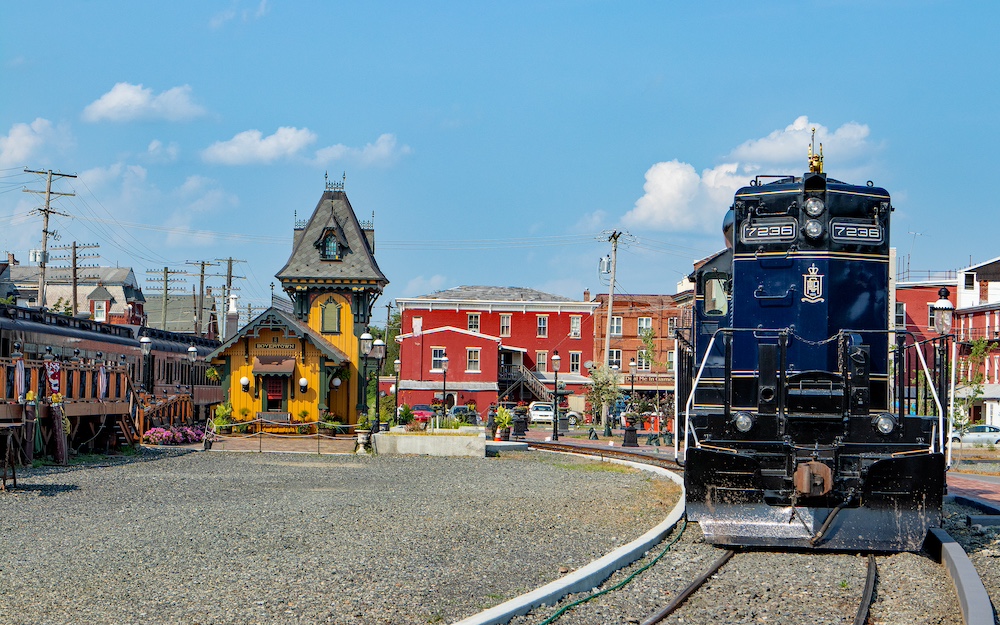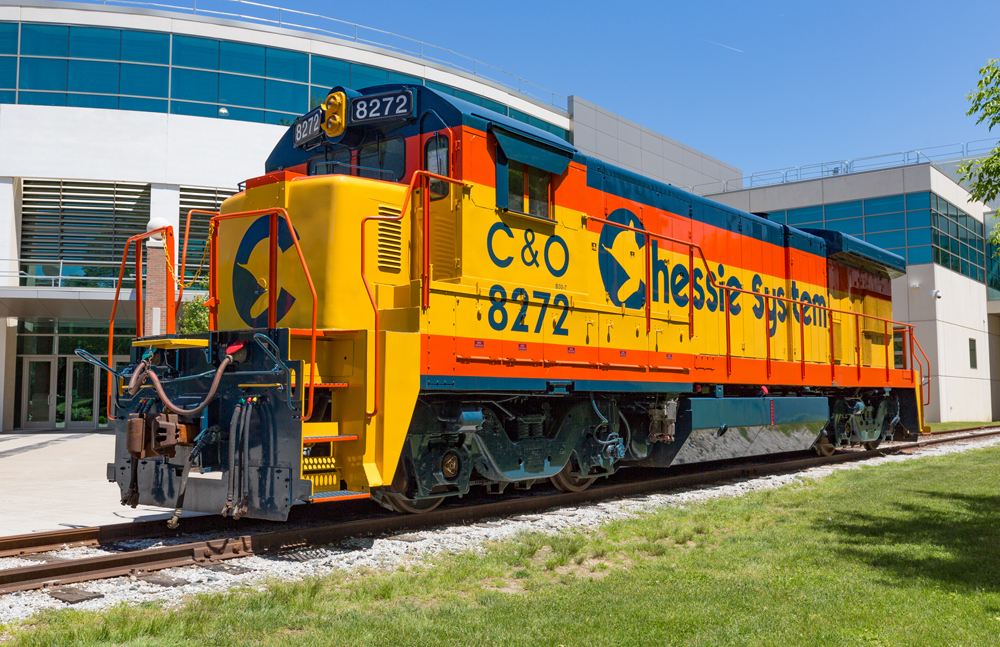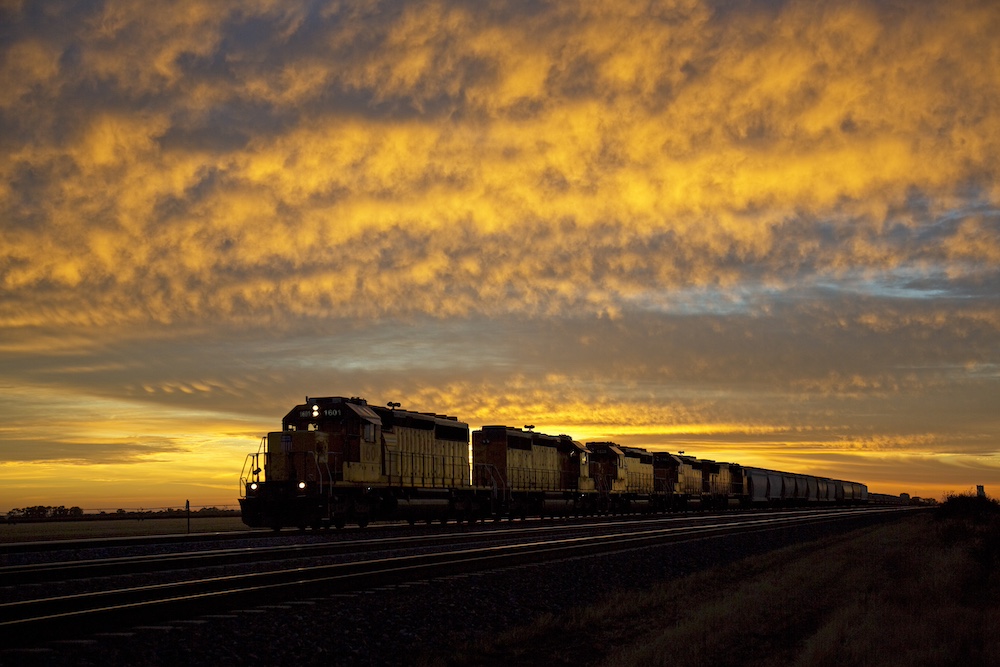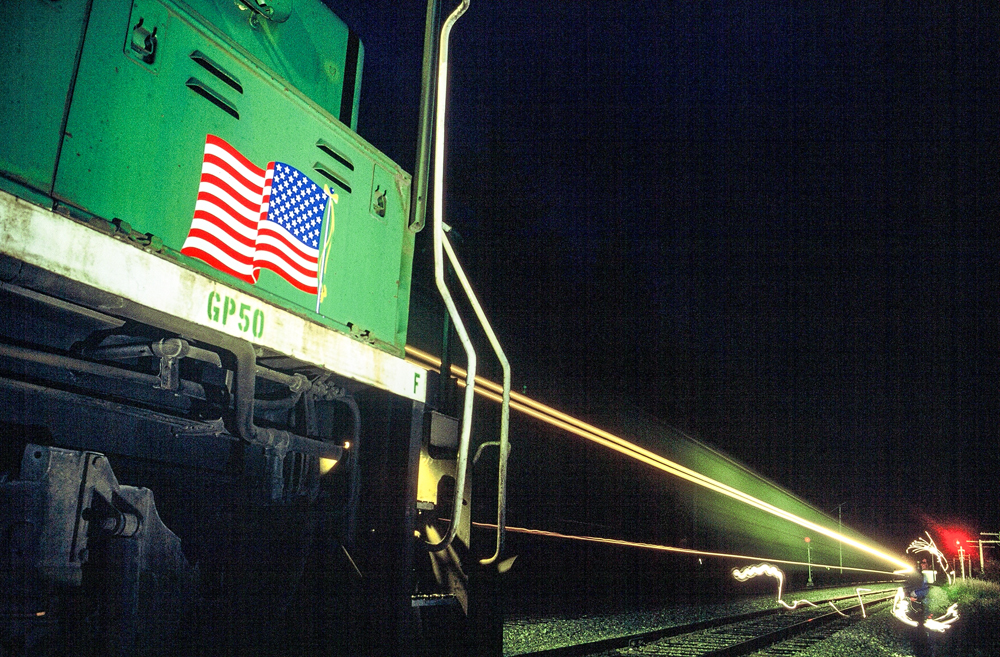The Missouri-Kansas-Texas Railroad is perhaps best summed up by two words: deterioration and reconstruction. Seldom has a railroad managed to survive the number of disasters, both natural and contrived, that befell the Katy. Its 1865 charter was for the Union Pacific Southern Branch. Although it connected with the Kansas Pacific (merged by UP in 1880) at Junction City, Kans., the new road had no legal relationship with its namesake.
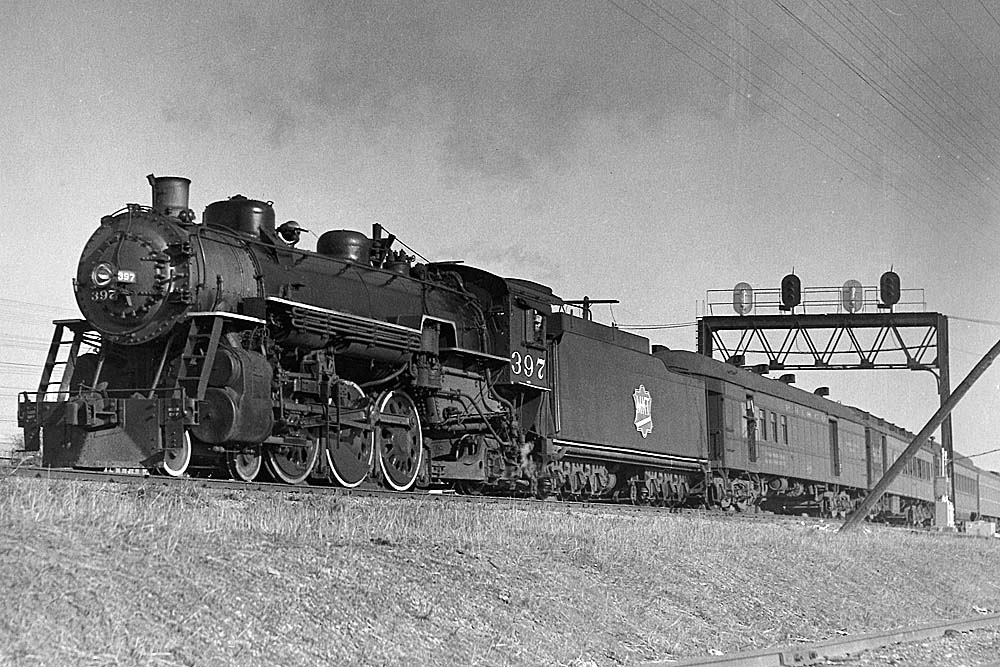
In less than two years the UPSB came under control of New York investors led by Judge Levi Parsons. By 1870 Parsons envisioned a grand future for his 70-mile railroad, and proposed that it connect Kansas City with ports on the Gulf of Mexico. Accordingly, he changed the name to Missouri, Kansas & Texas Railway, and soon it was identified on stock exchanges by “KT,” from which sprang its popular nickname.
Promised a Federal land grant for building through Indian Territory (later to become Oklahoma), MK&T battled mother nature, hostile natives, and competing railroads before reaching Texas in December 1872, ending at a point named for the road’s vice president, George Denison. Construction crews then moved northward and, by August 1873, had completed an extension to Hannibal, Mo., on the Mississippi River (the Moberly-Hannibal segment would wind up with the Wabash). At this point, a weary Parson decided to exit railroading, and only two weeks after liquidating his Katy holdings, the lucky judge witnessed the national Panic of 1873.
The fiscal ruin of the MK&T was an opportunity for Jay Gould, who controlled Missouri Pacific and Texas & Pacific. He acquired the Katy to use as a collection of feeder lines. Not surprisingly, this involved a massive transfer of Katy assets to other Gould lines, plus route acquisitions in north Texas that enlarged MK&T so it could better support MP and T&P. Gould’s recklessness led to legal action by the State of Texas that cost him control of MK&T, which entered its first bankruptcy in 1888.
Emerging in 1891, MK&T began a 20-year rebuilding that extended it to Austin, San Antonio, Houston, and St. Louis, with newer rolling stock and improved roadbed. Mounting debt from earlier bond issue and increasing costs from World War I traffic, however, pulled it back into insolvency in 1915. When USRA control ended in 1920, the Katy was again ailing financially and physically. Another rescue was needed.
The reorganization of 1923 brought a modified name, Missouri-Kansas-Texas Railroad, and the shedding of nearly 500 miles of unproductive routes (from a total of 3,860). Rehabilitation ended abruptly, though, when the stock market crashed in 1929, and by 1934, operating revenues were little more than half of those in 1930. Fortunately, another savior appeared: Matthew Sloan. With a background in electric utilities, he was able to secure funds from the Federal government and private banks. To promote a bright public image, he had every rebuilt freight car, plus company buildings, painted yellow with black trim.
Eschewing a business car, Sloan roamed the MKT in a yellow Chrysler sedan fitted with pilots and permanently mounted flanged wheels. He inaugurated named freights (Katy Komet and Klipper) and improved service on the four major passenger trains (Texas Special, Bluebonnet, Katy Flyer, and Katy Limited). The trains served both of Katy’s Missouri gateways, St. Louis and Kansas City, as well as all its big Texas terminals, with separate sections north of Parsons, Kans., and south of Denison.
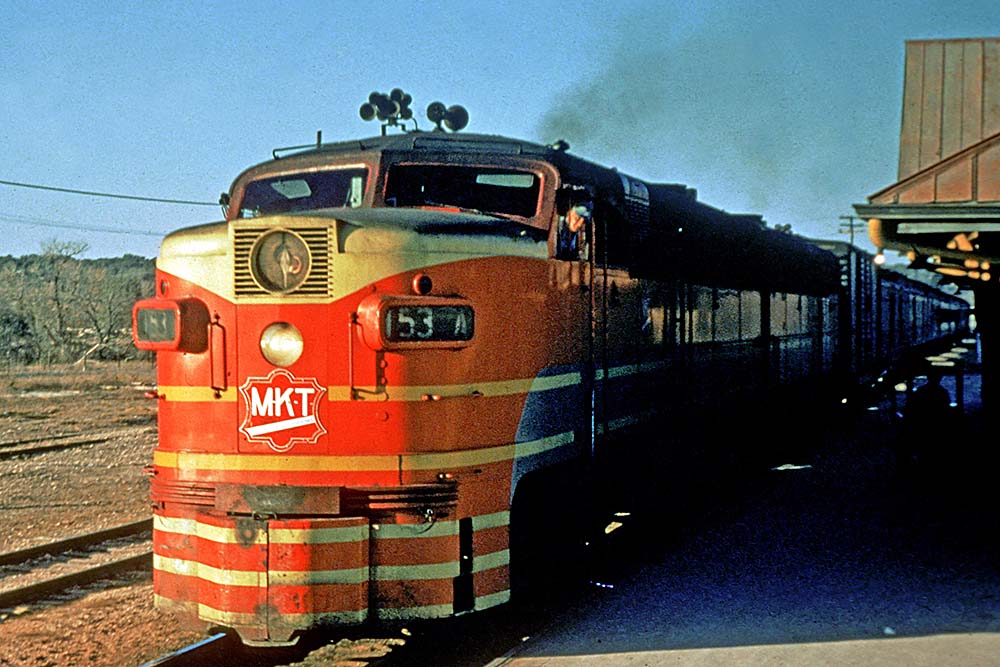
Through the early 1950s, Katy prospered with Korean War traffic, but postwar carloadings fell rapidly, compounded by an eight-year drought that decimated agricultural business. Operating problems began to mount, aggravated by the premature aging of 3 million poorly creosoted World War II crossties.
Searching for a “tough” operating man in the late 1950s, Katy brought in William Deramus III, who had rescued the Chicago Great Western. Despite a blunt approach that created public relations problems on and off the railroad, he was able to get Katy moving forward again. Yards were modernized and freight classification procedures streamlined, allowing more competitive schedules. He simplified diesel colors from a bright red with a detailed herald, silver side panels, and yellow trim to a solid red relieved only by small gold-painted “squashed” heralds that bore the road’s nickname in block letters. This plain scheme was similar to the darker red Deramus had applied to CGW engines.
Like many railroad leaders of the period, he also presided over the gradual reduction of Katy passenger service. Even these measures did not bring profitability, and a major investor shakeup in 1961 led to another management team whose results over the next three years were not significantly better.
This set the stage for Katy’s final rehabilitation, which began in March 1965 under the famous “doctor to sick railroads,” John W. Barriger III. Recently retired from the prosperous Pittsburgh & Lake Erie, “JWB,” a Dallas native, returned to his roots to rescue the Katy. He was familiar with its situation after having reviewed its government loan applications during the Great Depression. Following Sloan’s earlier recipe, Barriger began by cleaning, repairing, and repainting Katy equipment and structures, starting a track and roadway rehabilitation program, and becoming a tireless Katy promoter with a business card that read, in part, “traveling freight agent.”
Unable to cover the 20% down payment on equipment trusts, he signed 15-year leases on nearly 4,000 cars, and combined trade-ins and wreck insurance claims to purchase 11 GP40s, the road’s first second-generation diesels. Barriger also had all equipment painted a brighter red featuring big white “M-K-T” letters and the reborn classic Katy herald. He was not able to justify operating the last (Kansas City-Dallas) remnant of the Texas Special, though, and it came off June 30, 1965.
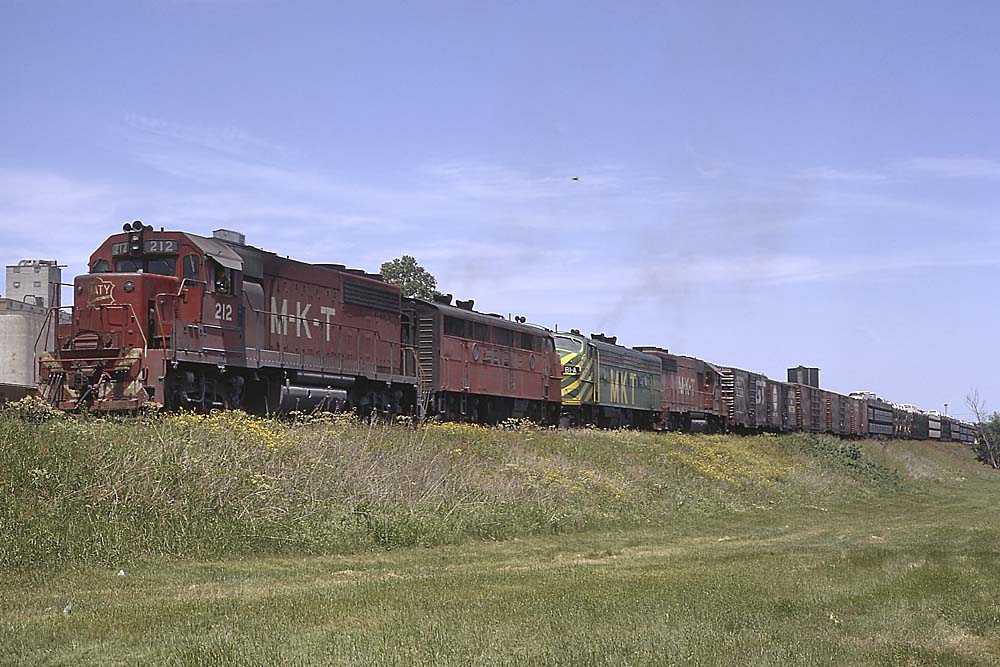
After Barriger’s second retirement in 1970, Reginald Whitman became president and built the Katy toward its pinnacle, which included a new (and final) color scheme of green and yellow (often called the “John Deere” look). Using government-guaranteed loans, Katy’s premier Kansas City-Fort Worth-Houston line was rebuilt to Class 4 (60 mph) status in the early 1980s. Although the railroad’s granger legacy was a distant memory, the government’s entry into the international grain business provided abundant export traffic for the system. After Rock Island’s 1980 demise, it also included new subsidiary Oklahoma, Kansas & Texas, the former RI Fort Worth-Abilene, Kans., line and a few branches.
What really brought Katy back from the brink of yet another disaster, however, was a government mandate in the 1970s for burning low-sulfur Western coal in electric generating plants along MKT routes. Unlike seasonal agricultural traffic, this new “black gold” provided a steady demand covered by long-term contracts. Alas, while Katy was increasing its traffic base in the 1970s, the merger movement was producing larger competing lines even faster, and soon MKT found itself surrounded by a bigger Burlington Northern (now including Frisco) and UP (including MoPac). Katy’s independence was clearly in jeopardy, and the resilient road vanished into the UP in May 1988.

